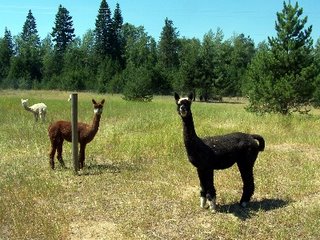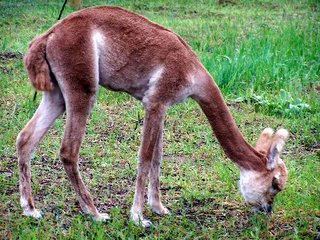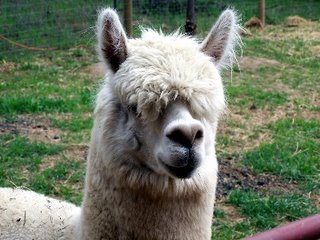Fiber facts, Fiber testing, Fiber evaluations
Most of you ranchers probably have such a program going, but we at Pedro's Pride Ranch have finally gotten our act a bit better together and we are now engaged in testing fleeces and getting professional advice on developing our breeding program further. Let me explain:
Our breeding program is simple--
1. Strong, healthy alpacas with a guaranteed genetic diversity
2. Fineness and handle in fleeces
3. Added staple length and density for more weight
4. Brightness and color
5. Crimp, crinkle and character as defined by the textile industry (as opposed to AOBA show judges)
To further these goals, we have bred Pedro Armendariz, whose fleeces have won several ribbons and produces about 12 pounds of brilliant fiber per year, with award-winning 007's Leila and Lois Maxwell, both white with fine fleece characteristics. The resulting four crias (3 girls, one boy) have carried forward the best qualities of each parent. They all exhibit Pedro's brilliant fleece and extreme density. All four also show exquisite fleece character with high curvature numbers and wonderful scores on "spin fineness" and "comfort factor."
Pedro and Leila's 2006 cria, Paloma of Pend Oreille was born April 20th. We tipped her entire fleece two weeks later. Today (August 12th) her fleece is a solid four inches long and formed in gorgeous locks with crimp evident from skin to tip. This fleece was evaluated as exceptionally fine, silky fleece with a fantastic commercial value. We will show her in the Spring 2007.
Lilly (Pedro and Leila) and Lola (Pedro and Lois) were tested at 18 months of age. These recent histograms prove what we suspected--they have incredible fleeces. Not only are these girls' fleeces "brilliant throughout" (as the judge at Alpacapalooza noted for
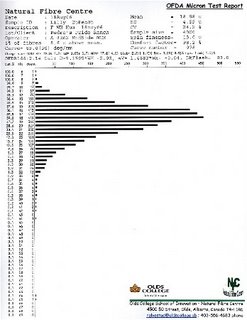 Lilly), but they are dense, fine and have unheard-of curvature and comfort factor scores.
Lilly), but they are dense, fine and have unheard-of curvature and comfort factor scores.Here is Lilly's histogram, with key factors to note being, mean diameter at 18.98, comfort factor 98.2% and curve at 69 deg/mm.
Lola scores even higher with mean of 17.19, comfort factor at an outstanding 98.7 % and curve at a remarkable 82.8 deg/mm.
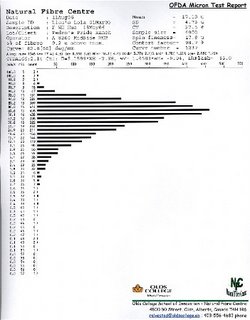
Pedro's histogram (I can't scan it because I don't have a scanner) shows the traits we are seeking, with mean diameter below the national average at 25.87 microns, confort factor of 84.5 % and an excellent curve of 51.3 deg/mm. His fleece quality shows excellent uniformity with a low CV and with 5 % of fibers= 9.0 microns above mean. These traits, combined with 12 pounds per year production and several judges' evaluations of the fineness and handle of his fleece, make Pedro an excellent choice for us to continue our program and for other ranchers looking for fineness, handle and weight.
Pedro would be happly cooperate with a breeding for you and we will be happy to provide 100 % financing and free care of your dam (and her cria) while visiting with Pedro.
Enough commericalization. Back to my point. As the next step in our breeding program we will put Kenai of Pend Oreille in service in 2007. He carries some wonderful genetics and his fleece shows definate signs of throwing gray. Kenai is the son of Premier's Absolute, whose record speaks for itself-- Oh, yeah, and he recently sold at auction for $150,000!
Also, adding to this breeding program is the introduction of the award-winning qualities of Alpacas de la Patagonia. While at that website, look at herdsires, Guevara, Lennox and Kaspa. We have purchased two pregnant females from them and our two girls -- Lilly and Lola -- are now bred to two of Patagonia's most famous herdsires.
Lilly is bred to Patagonia's Kaspa, the 2003 AOBA Gray Male Champion. He is a rose gray and looks almost pink. He is a striking-looking male with fine fiber and wonderful fleece characteristics in addition to his gorgeous color.
Lola is now bred to Patagonia's reknown herdsire, Patagonia's Lennox. He sports a rich, brown fleece with fabulous, high amplitude, tight crimp. Like Kaspa, he has a remarkable show record and a string of offspring that have carried on the winning tradition, including the fineness, handle and low-micron fiber diameters we all expect from this professional ranch.
Finally, to the point I wanted to make-- I am thinking that part of any fleece development program or breeding program for that matter, should include the consultation of experts. Thus, we have been relying heavily on the advice and positive approach of Carrie Hull at Timber_Basin Ranch. timber_basin@hotmail.com. [there is an underscore _ between timber and basin]. Carrie is vastly experienced and has formal training in analyzing fleeces. Her approch is very valuable because she understands both alpaca breeding and the textile industries' needs. Carrie will take your fleece and for a very reasonable fee, provide you with a written analysis. The last one she did for us including the following components, each of which is useful and dependable:
Fleece stats--weight, average staple length, grade (our last one was Grade 2, which is not too shabby) and crimps per inch.
She then gives a written explanation of her findings in the following categories:
Crimp style and character
Density
Handle
Color (including uniformity and variations)
Other -- which might include things like health or conditioning issues (Carrie was herd health person for Snowmass, after all)
Strengths -- those qualities that make the fleece more valuable or usable in the textile industry, for example
Improvement Areas -- here is where you get Carrie's expertise and recommendation for future breedings
DID YOU KNOW-- Angus McColl from Yokum-McColl fiber testing labs averaged all of the alpaca fleece histograms done for a full year and found that the AVERAGE MICRON WAS 28. And, did you know that the benchmark (according to Carrie Hull) for uniformity of a fleece is 20 microns, 4.4 SD, 20 CV. [Carrie told me these things, so it is not my research].
That's it for now. Please join us in this blog. Write comments by clicking below, or add your posting by letting us know you want to post and we will give you access.
And, here's a good idea. Before school starts and you all get busy with other things, take a family outing and visit an Alpaca Ranch near you. Pedro's Pride Ranch is in north Idaho, a short, scenic drive from Spokane and CdA. Yakima River Alpacas and Enchanted Acres Ranch are located in the Tri-Cities area of eastern Washington and would make a wonderful day trip.
If you want to visit an Alpaca Ranch, but are not close to those I listed, please e-mail me at pedrospride@hughes.net and we can find one near you.
All our best,
Ken & Lisa Larson
